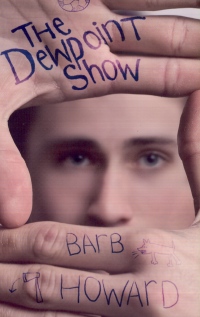| ________________
CM . . .
. Volume XVII Number 9. . . .October 29, 2010
excerpt:
In The Dewpoint Show, Howard introduces readers to quirky 13-year-old protagonist Leonard Pierson (named after his parents’ eye surgeon), an awkward teenager who practices the powers of observation by staring out his window for hours on end (if he can get away with it). His mom, Barbara, calls his habit lazy, and neighbours find him nosy, but Leonard insists it’s no different than watching television. When his mom and dad decide to move from the big city to the small town of Dewpoint for “privacy,” Leonard finds himself in the irksome position of having to make new friends when he’d prefer to sit back and contemplate life. Unfortunately, his choice of friends is limited—hyperactive Devon from his soccer team who has extremely violent tendencies and enjoys kicking balls at one’s nether regions or wrinkled old Vivian from next door who is building a hot tub and owns a three-legged dog named Tripod. Luckily for Leonard, he gets to finish the year at his old school in the city so the rush to make new friends is reduced and his chances to see his crush, Brianne—she of multiple piercings and fierce independence—are improved.
The most important character to Leonard’s story, however, is Vivian. Far from being a powerless senior citizen, Vivian--whose name brings to mind the Latin word vivi meaning life and alive--is a vivacious and capable woman whose hot-tub construction reveals her independent streak. Indeed, to Leonard’s practiced observation, Vivian resembles a skateboarder kid more than she resembles an old lady. When Vivian teaches Leonard a trick (how to flip Jell-o cubes from his elbow into his mouth), she confirms Leonard as a life-long friend. Vivian’s ‘joie de vivre’ motivates Leonard to add some actions to his routine of observations. Although, for all the good that Vivian is supposed to do Leonard, their friendship seems somewhat underdeveloped as only a handful of scenes show the two of them actually interacting. Howard weaves passages into the narrative which resemble cuts from a movie script complete with a “zoom in” and a “zoom out” that corresponds with Leonard’s powers of observation. These brief excerpts gain more meaning at the end of the book when Leonard is bestowed with his parents’ old video camera—a chance to capture his observations on film and to take part in the stories surrounding him rather than just watch from afar. In addition to the movie script segments, Howard includes brief vignettes from other characters’ points of view including Barbara; Leonard’s dad, Richard; and Vivian among others. These clips serve as “pauses” in the action of the story. While interesting to witness the perceptions of supporting characters, these sections are a bit disruptive to the overall flow of the narrative. The epilogue or “sequel” provides a sugary sweet ending to the book, that, although comforting and satisfying, is a bit cheesy in its implication that friendships and crushes formed at age 13 are blessedly realized and satisfied five years later. Leonard’s part-time job as a hot-tub salesperson certainly adds a humorous twist to the fanciful ending that left me chuckling as I closed the book, and I couldn’t help but wonder if Leonard still sported his beloved faux-hawk at age 18. Recommended. Meghan Radomske is a student in the Master of Library and Information Studies Program at the University of British Columbia and the Writing & Book Camp Coordinator at Vancouver Public Library. Copyright © the Manitoba Library Association. Reproduction for personal
use is permitted only if this copyright notice is maintained. Any
other reproduction is prohibited without permission.
NEXT REVIEW |
TABLE OF CONTENTS FOR THIS ISSUE
- October 29, 2010.
AUTHORS |
TITLES |
MEDIA REVIEWS |
PROFILES |
BACK ISSUES |
SEARCH |
CMARCHIVE |
HOME |
